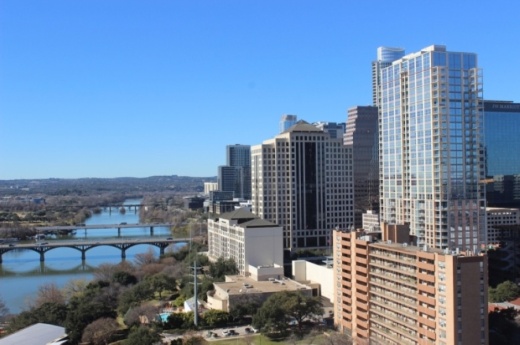"The much-anticipated light at the end of the tunnel is burning brightly for Austin and downtown because of the adaptability we have witnessed from business owners, the hospitality industry and signs pointing to a record-setting 2021 for the development of Class A office space in downtown," DAA President and CEO Dewitt Peart said during an April 21 videoconference.
The DAA's outlook for sustained growth projected in its 2021 annual report comes after a year that saw business and entertainment venue patronage, tourism, and in-person office work and occupancy plummet throughout the approximately 1,100-acre Austin downtown, according to DAA Director of Research and Analysis Jenell Moffett.
“Not only is it the central business district, it’s where you hear live music; it’s where you attend your favorite concert or show; it’s where you eat at your favorite restaurant ... and the list goes on and on," she said. "Downtown is truly a place for everyone, and COVID-19 tried to change that."
One of the most visible examples of the pandemic's effect on the downtown economy is the dozens of spaces that permanently closed their doors through 2020 and early 2021. Moffett said declining activity from residents, commuters and tourists alike contributed to the closures of 10 music and event venues and 88 storefronts tracked by the alliance downtown since last March. Alongside nearly 100 unconfirmed new business vacancies, she said between one-fifth and one-quarter of downtown's storefronts were shuttered through the pandemic as consumer spending fell more than 50% below 2019 levels in spring 2020, according to alliance data.
Despite the drop-off in street-level activity downtown over the past year, alliance staff said development and investment in Austin's core is not slowing down anytime soon. Millions of square feet of residential, office and hotel space are expected to come online at dozens of new buildings across downtown now under construction or in planning, according to the alliance's projects database.
"All indicators at this point show that past momentum will continue," Moffett said. "There’s clearly optimism and opportunity that sparks interest of so many people. We must continue to plan and prepare for their arrival. Downtown is continuously evolving and many of these measures are changing right now as I speak."
Future resiliency
Peart also said the alliance is working to strengthen downtown's post-pandemic outlook through four main priorities outlined in its newly developed plan for recovery and resiliency. Those items include support for small businesses and live music venues, tackling the city's unsheltered homelessness, improving parks and public spaces, and the continuing promotion of the entire downtown district.
While Moffett said the alliance did see some new business openings in the past year and expects further launches downtown as vaccinations increase and warmer weather arrives, Molly Alexander, executive director of the Downtown Austin Alliance Foundation, also said a new initiative aimed at enlivening empty storefronts is planned to utilize lingering vacant spaces this year. In addition to advocating for new business and venue funding, part of the alliance recovery plan includes partnerships to turn empty shops and walkways into interactive spaces for visitors and residents.
"We are in the process of piloting a program that supports artists, art organizations and the underserved creative community by partnering with property owners to transform those vacant storefronts and unused real estate in order to create and present art, and we are activating the streets, sidewalks and areas for musicians, makers and performers to provide COVID-safe, active and engaging experiences," Alexander said.
With the alliance's participation in a recent city summit on homelessness, collaboration on improvements to city parks and greenways, and coordination on a range of planned mobility projects in Austin, Peart said partnerships reaching outside the central downtown area have also been identified as a necessary focus coming out of the pandemic.
"Downtown cannot be resilient on its own. We’re part of a regional economy if not a mega regional economy, and I think as a region downtown plays a very important role in all of that," he said.





